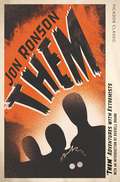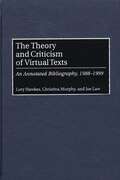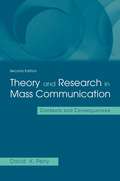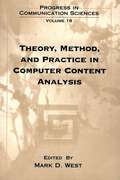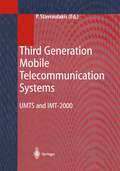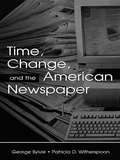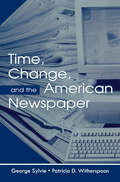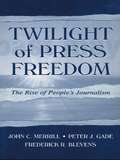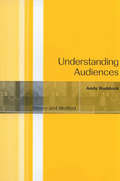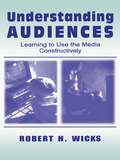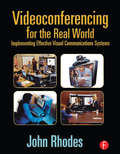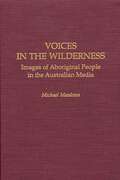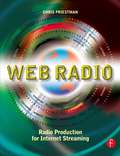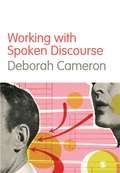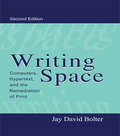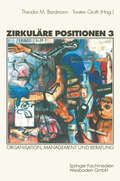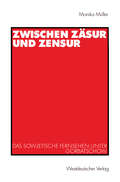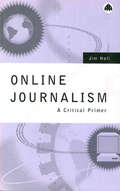- Table View
- List View
Them: Secret Rulers of the World (Picador Classic #18)
by Jon RonsonWith an introduction by Russell BrandWhat if a tiny, shadow elite rule the world from a secret room?My worryingly paradoxical thought process could be summarized thus: Thank God I don't believe in the secret rulers of the world. Imagine what the secret rulers of the world might do to me if I did.What if a tiny, shadow elite rule the world from a secret room? In Them Jon Ronson sets out to find this room, with the help of the extremists - Islamic fundamentalists, neo-Nazis, Ku Klux Klansmen - that believe in it. Along the way, he is chased by men in dark glasses, unmasked as a Jew in the middle of a Jihad training camp, and witnesses international CEOs and politicians participate in a bizarre pagan ritual in the forests of northern California.A Sunday Times bestseller and the book that launched Jon Ronson's inimitable career, Them is an eye-opening, outrageously funny exploration of extremism, which makes both author and reader think twice about the looking-glass world of 'us' and 'them' . . .
The Theory and Criticism of Virtual Texts: An Annotated Bibliography, 1988-1999 (Bibliographies and Indexes in Library and Information Science)
by Lory Hawkes Joe Law Christina MurphyVirtual texts have emerged within the realm of the Internet as the predominant means of global communication. As both technological and cultural artifacts, they embody and challenge cultural assumptions and invite new ways of conceptualizing knowledge, community, identity, and meaning. But despite the pervasiveness of the Internet in nearly all aspects of contemporary life, no single resource has cataloged the ways in which numerous disciplines have investigated and critiqued virtual texts. This bibliography includes more than 1500 annotated entries for books, articles, dissertations, and electronic resources on virtual texts published between 1988 and 1999.Because of the multiple contexts in which virtual texts are studied, the bibliography addresses virtual communication across a broad range of disciplines and philosophies. It encompasses studies of the historical development of virtual texts; investigations of the many interdisciplinary applications of virtual texts and discussions of such legal issues as privacy and intellectual property. Entries are arranged alphabetically within topical chapters, and extensive indexes facilitate easy access.
Theory and Research in Mass Communication: Contexts and Consequences
by David K. PerryThis updated edition presents a civic journalism treatment of the field of mass communication research. The sine qua non of the civic journalism movement seems to center around an implicit assumption that the human mind is an evolved part in the natural world, not a detached spectator as much traditional philosophy assumes. Thus, it has attempted to encourage journalists and members of their audiences to participate actively in civic life. Applying the same idea to mass communication academics, this book focuses on the empirical consequences of their work, especially its possible impact on human life. It argues that researchers need to connect with the broader communities in which they live and considers the impact of media research on society. Features of the second edition include: *detailed update of research evidence concerning the media violence issue; *additional material concerning media ownership structures and their possible relationship to media content and effects; *new material focusing on the impact of tobacco and alcohol advertising; *updated and expanded section concerning the history of media studies; and *an expanded discussion of philosophical issues pertaining to theory construction. This book is intended for graduate and advanced undergraduate students studying mass communication theory and related subjects, such as communication theory, media effects, media literacy, and media and society.
Theory and Research in Mass Communication: Contexts and Consequences (Routledge Communication Ser.)
by David K. PerryThis updated edition presents a civic journalism treatment of the field of mass communication research. The sine qua non of the civic journalism movement seems to center around an implicit assumption that the human mind is an evolved part in the natural world, not a detached spectator as much traditional philosophy assumes. Thus, it has attempted to encourage journalists and members of their audiences to participate actively in civic life. Applying the same idea to mass communication academics, this book focuses on the empirical consequences of their work, especially its possible impact on human life. It argues that researchers need to connect with the broader communities in which they live and considers the impact of media research on society. Features of the second edition include: *detailed update of research evidence concerning the media violence issue; *additional material concerning media ownership structures and their possible relationship to media content and effects; *new material focusing on the impact of tobacco and alcohol advertising; *updated and expanded section concerning the history of media studies; and *an expanded discussion of philosophical issues pertaining to theory construction. This book is intended for graduate and advanced undergraduate students studying mass communication theory and related subjects, such as communication theory, media effects, media literacy, and media and society.
Theory, Method, and Practice in Computer Content Analysis (Progress in Communication Sciences)
by Mark D. WestIn recent years, computer content analysis has undergone something of a renaissance. Inexpensive and powerful desktop computers mean that computer analysis of texts is available to most researchers. The availability of software to do analyses, however, is not always linked to clear theoretical and methodological understandings. This volume seeks to deal with this concern by providing, from scholars in a variety of disciplines, perspectives upon the theoretical and methodological issues which arise when conducting content analysis via computer. Although it is not always obvious, computer content analysis is a method which inevitably calls for theoretical assumptions. Those theoretical assumptions in turn drive methodological considerations, and method in turn determines the form of the practice of computer content analysis.This volume includes ten articles by well-known scholars utilizing computer content analysis. A variety of methodological, theoretical, and practical issues are here addressed, presenting unique methods and perspectives for the consideration of computer content analysis. Intended for an audience of graduate students, scholars, and in-field practitioners, Theory, Method and Practice of Computer Content Analysis will serve as an invaluable resource of ideas and practices for those interested in using computers to analyze textual material.
Third Generation Mobile Telecommunication Systems: UMTS and IMT-2000
by Peter StavroulakisOne hundred years ago, the notion of transmitting information without the use of wires must have seemed like magic. In 1896, the first patent for wireless communication was granted to Marchese Guglielmo Marconi. Since then the field of wireless communications which includes cellular systems has taken various forms of development. It basically evolved through three Eras. The Pioneer Era over the period of 1860-1921, the Precellular Era over 1921-1980 and the Cellular Era after 1980 and beyond. The first generation cellular era started with the Analog Systems and evolved in the digital domain utilizing Time Division Multiple Access (TDMA) and Code Division Multiple Access (CDMA), thus comprising the Second Generation Mobile Systems. The first generation RF cellular communications systems deployed in the early to mid 1980's had air interfaces comprised of analog technology. Among them were AMPS (Advanced Mobile Phone System), NMT (Nordic Mobile Telephone), and TACS (Total Access Communications System). These were designed for use in a specific geographic area and not intended to be deployed in other areas. There was not much commonality beyond using the same air interface technology and same modulation. The air interface technology was Frequency Division Multiple Access (FDMA) and the modulation was analog FM, but with different deviations and channel spacings. The frequency bands, air interface protocols, number of channels, and data rates were different. In general, these systems provided local and national coverage.
Time, Change, and the American Newspaper (Routledge Communication Series)
by George Sylvie Patricia D. WitherspoonTime, Change, and the American Newspaper focuses on newspapers as organizations, examining the role of change in the newspaper industry and providing a model from which to view and respond to change. Authors George Sylvie and Patricia D. Witherspoon discuss environmental and organizational influences on contemporary newspapers, and they analyze newspapers within the larger context of all organizations. This more general perspective provides insights into the nature of change, the change process, the rationale for organizational changes, resistance to such changes, and initiation and implementation strategies. In its examination of change, this volume explores the causes of newspaper change, how newspaper change takes shape, and when change does not work. This consideration sets the stage for detailed case studies examining the roles of new technology, product, and people as change agents in newspapers. The discussion concludes with the impact of change--or lack of it--on the contemporary newspaper industry and the subsequent impact of newspaper change on society. Sylvie and Witherspoon propose future directions of change and of newspaper decision-making processes pertaining to change, and they offer suggestions for changes in newspaper structures and thought processes. Providing a sound, theoretically-based approach to the topic of change and American newspapers, this volume is essential reading for educators and students in journalism, media/newsroom management, media economics, organizational behavior/communication, and related areas. It also provides a wealth of insights and practical knowledge for newspaper publishers, editors, and practicing journalists.
Time, Change, and the American Newspaper (Routledge Communication Series)
by George Sylvie Patricia D. WitherspoonTime, Change, and the American Newspaper focuses on newspapers as organizations, examining the role of change in the newspaper industry and providing a model from which to view and respond to change. Authors George Sylvie and Patricia D. Witherspoon discuss environmental and organizational influences on contemporary newspapers, and they analyze newspapers within the larger context of all organizations. This more general perspective provides insights into the nature of change, the change process, the rationale for organizational changes, resistance to such changes, and initiation and implementation strategies. In its examination of change, this volume explores the causes of newspaper change, how newspaper change takes shape, and when change does not work. This consideration sets the stage for detailed case studies examining the roles of new technology, product, and people as change agents in newspapers. The discussion concludes with the impact of change--or lack of it--on the contemporary newspaper industry and the subsequent impact of newspaper change on society. Sylvie and Witherspoon propose future directions of change and of newspaper decision-making processes pertaining to change, and they offer suggestions for changes in newspaper structures and thought processes. Providing a sound, theoretically-based approach to the topic of change and American newspapers, this volume is essential reading for educators and students in journalism, media/newsroom management, media economics, organizational behavior/communication, and related areas. It also provides a wealth of insights and practical knowledge for newspaper publishers, editors, and practicing journalists.
Twilight of Press Freedom: The Rise of People's Journalism (Routledge Communication Series)
by John C. Merrill Peter J. Gade Frederick R. BlevensThis volume offers a historical, philosophical, and practical critique of public and civic journalism--a movement that gained momentum in the final decade of the 20th century. During that period, proponents of the movement have published nearly a dozen books expanding upon and expounding the virtues of journalism, seeking to repair what is thought to be the torn social, political, and moral fabric in America. Although previous works have established a strong practical underpinning for public and civic journalism, none has examined its philosophical roots or challenged its methodology and grounding in neoliberal constructs. This volume does just that, tracing its origins in early philosophy to the current newsroom policies and practices that conflict with traditional constructs in libertarian press theory. Twilight of Press Freedom postulates that institutionalized journalism is fading away and world journalism--prompted by the people--is veering toward more order and social harmony, and away from the traditional idea of the great value of press freedom. The volume provides a critical examination of the trend toward public journalism and considers how press freedom will be impacted by this trend in coming years. Scholars and students in journalism, public opinion, and media studies will find this book insightful and invaluable.
Twilight of Press Freedom: The Rise of People's Journalism (Routledge Communication Series)
by John C. Merrill Peter J. Gade Frederick R. BlevensThis volume offers a historical, philosophical, and practical critique of public and civic journalism--a movement that gained momentum in the final decade of the 20th century. During that period, proponents of the movement have published nearly a dozen books expanding upon and expounding the virtues of journalism, seeking to repair what is thought to be the torn social, political, and moral fabric in America. Although previous works have established a strong practical underpinning for public and civic journalism, none has examined its philosophical roots or challenged its methodology and grounding in neoliberal constructs. This volume does just that, tracing its origins in early philosophy to the current newsroom policies and practices that conflict with traditional constructs in libertarian press theory. Twilight of Press Freedom postulates that institutionalized journalism is fading away and world journalism--prompted by the people--is veering toward more order and social harmony, and away from the traditional idea of the great value of press freedom. The volume provides a critical examination of the trend toward public journalism and considers how press freedom will be impacted by this trend in coming years. Scholars and students in journalism, public opinion, and media studies will find this book insightful and invaluable.
Understanding Audiences: Theory and Method
by Dr Andy RuddockThe history of audience research tells us that the relationship between the media and viewers, readers and listeners is complex and requires multiple methods of analysis. In Understanding Audiences, Andy Ruddock introduces students to the range of quantitative and qualitative methods and invites his readers to consider the merits of both. Understanding Audiences: demonstrates how - practically - to investigate media power; places audience research - from early mass communication models to cultural studies approaches - in their historical and epistemological context; explores the relationship between theory and method; concludes with a consideration of the long-running debate on media effects; includes exercises which invite readers to engage with the practical difficulties of conducting social research.
Understanding Audiences: Theory and Method
by Andy RuddockThe history of audience research tells us that the relationship between the media and viewers, readers and listeners is complex and requires multiple methods of analysis. In Understanding Audiences, Andy Ruddock introduces students to the range of quantitative and qualitative methods and invites his readers to consider the merits of both. Understanding Audiences: demonstrates how - practically - to investigate media power; places audience research - from early mass communication models to cultural studies approaches - in their historical and epistemological context; explores the relationship between theory and method; concludes with a consideration of the long-running debate on media effects; includes exercises which invite readers to engage with the practical difficulties of conducting social research.
Understanding Audiences: Learning To Use the Media Constructively (Routledge Communication Series)
by Robert H. WicksUnderstanding Audiences helps readers to recognize the important role that media plays in their lives and suggests ways in which they may use media constructively. Author Robert H. Wicks considers the relationship between the producers and the receivers of media information, focusing on how messages shape perceptions of social reality. He analyzes how contemporary media--including newspapers, film, television, and the Internet--vie for the attention of the audience members, and evaluates the importance of message structure and content in attracting and maintaining the attention of audiences. Wicks also examines the principles associated with persuasive communication and the ways in which professional communicators frame messages to help audiences construct meaning about the world around them. Among other features, this text: * describes the processes associated with human information processing; * presents an analysis of the principles associated with social learning in children and adults and explores the possibility that media messages may cultivate ideas, attitudes, and criticisms of this perspective; * explains how most media messages are framed to highlight or accentuate specific perspectives of individuals or organizations--challenging the notion of objectivity in media information messages; * considers the effects of media exposure, such as whether the contemporary media environment may be partially responsible for the recent rash of school violence among young people; * analyzes the Internet as an interactive medium and considers whether it has the potential to contribute to social and civic disengagement as it substitutes for human interaction; and * evaluates the principles of the uses and gratifications approach as they apply to the new media environment, including traditional media as well as popular genres like talk shows and developing media systems such as the Internet. Intended for upper-level undergraduate and graduate students who need to understand the nature of the media and how they interact with these messages, Understanding Audiences promotes the development of media literacy skills and helps readers to understand the processes associated with engaging them in media messages. It also offers them tools to apply toward the shaping of media in a socially constructive way.
Videoconferencing for the Real World: Implementing Effective Visual Communications Systems
by John Rhodes"John Rhodes' Videoconferencing for the Real World, is a one of the world's most comprehensive blueprints on the awesome power of videoconferencing."From the Foreword by Brad CaldwellChairman ICIA and President ofIntegrated Media Services, Anaheim, CADesigned to be useful to both technical and non-technical managers, Video-Conferencing for the Real World demystifies the subject of video communications. It provides easy-to-follow guidelines for deploying a cost-effective video-conferencing solution tailored to an organization's specific needs.Developed to flexible to the readers need, Video Conferencing for the Real World offers dynamic problem-solving techniques for the communication challenges facing managers today. Examining the technical, economic, and organizational aspects of each requirement and solution, this book offers a sound base of technical information and provides practical solutions based on a wealth of professional experience. Combining his own ideas with the input of system managers and users, service providers, consultants, and manufacturers, the author has developed a guide that will help readers make more informed investments of their time and money. Special attention is paid to conducting an effective needs analysis, and the development of solutions that will adapt easily to future changes in organizational requirements.Covering a variety of solutions, this book explores the advantages and disadvantages of desktop systems, set-top systems, rollabout systems, and room systems. In addition to compression, multipoint conferencing and data conferencing, this book also addresses topics such as, pilot projects, the preparation of RFPs, service contracts, training, content creation, and convergence.
Videoconferencing for the Real World: Implementing Effective Visual Communications Systems
by John Rhodes"John Rhodes' Videoconferencing for the Real World, is a one of the world's most comprehensive blueprints on the awesome power of videoconferencing."From the Foreword by Brad CaldwellChairman ICIA and President ofIntegrated Media Services, Anaheim, CADesigned to be useful to both technical and non-technical managers, Video-Conferencing for the Real World demystifies the subject of video communications. It provides easy-to-follow guidelines for deploying a cost-effective video-conferencing solution tailored to an organization's specific needs.Developed to flexible to the readers need, Video Conferencing for the Real World offers dynamic problem-solving techniques for the communication challenges facing managers today. Examining the technical, economic, and organizational aspects of each requirement and solution, this book offers a sound base of technical information and provides practical solutions based on a wealth of professional experience. Combining his own ideas with the input of system managers and users, service providers, consultants, and manufacturers, the author has developed a guide that will help readers make more informed investments of their time and money. Special attention is paid to conducting an effective needs analysis, and the development of solutions that will adapt easily to future changes in organizational requirements.Covering a variety of solutions, this book explores the advantages and disadvantages of desktop systems, set-top systems, rollabout systems, and room systems. In addition to compression, multipoint conferencing and data conferencing, this book also addresses topics such as, pilot projects, the preparation of RFPs, service contracts, training, content creation, and convergence.
Voices in the Wilderness: Images of Aboriginal People in the Australian Media (Contributions to the Study of Mass Media and Communications)
by Michael MeadowsThis book examines race relations in Australia through various media representations over the past 200 years. The early colonial press perpetuated the image of aboriginal people as framed by early explorers, and stereotypes and assumptions still prevail. Print and television news accounts of several key events in recent Australian history are compared and reveal how indigenous sources are excluded from stories about their affairs. Journalists wield extraordinary power in shaping the images of cultures and people, so indigenous people, like those in North America, have turned away from mainstream media and have acquired their own means of cultural production through radio, television, and multimedia. This study concludes with suggestions for addressing media practices to reconcile indigenous and non-indigenous people.This study will appeal to students and scholars studying mass media, particularly journalism and public relations, Australian history, and sociology.
Web Radio: Radio Production for Internet Streaming
by Chris PriestmanAnyone wanting to set up a low cost web radio station will benefit from the advice and information provided by this book. Not only will you gain technical and practical know-how to enable your station to go live, but also an appreciation of the legal and copyright implications of making radio, potentially for international audiences and in the rapidly evolving environment of the web.To succeed, your radio content will need to be carefully planned and your station properly promoted. Advice is given on taking advantage of the scalability web radio introduces for building audiences in line with your resources, for scheduled live output and for making programmes available on demand, including music, news, speech radio and audience participation. Case studies from around the world are provided to demonstrate how different radio organisations are applying the new flexibility web radio has to offer in a wide range of situations. Together with its associated website www.web-radio-book.com, the book also acts as a starting point for locating a range of sources for further advice and lines of research. Learn how to: - go live with your own low cost web radio station (either managing the server yourself or using a host service) - assess the right server set-up to handle the number of simultaneous listeners expected - get the best sound quality to your listeners- take account of the range of devices available for receiving web radio- plan your station, programming and associated website - identify and reach your audience - build audience feedback and data into your station's strategy- tackle the additional legal and ethical dimensions of radio on the web - source more detailed information
Web Radio: Radio Production for Internet Streaming
by Chris PriestmanAnyone wanting to set up a low cost web radio station will benefit from the advice and information provided by this book. Not only will you gain technical and practical know-how to enable your station to go live, but also an appreciation of the legal and copyright implications of making radio, potentially for international audiences and in the rapidly evolving environment of the web.To succeed, your radio content will need to be carefully planned and your station properly promoted. Advice is given on taking advantage of the scalability web radio introduces for building audiences in line with your resources, for scheduled live output and for making programmes available on demand, including music, news, speech radio and audience participation. Case studies from around the world are provided to demonstrate how different radio organisations are applying the new flexibility web radio has to offer in a wide range of situations. Together with its associated website www.web-radio-book.com, the book also acts as a starting point for locating a range of sources for further advice and lines of research. Learn how to: - go live with your own low cost web radio station (either managing the server yourself or using a host service) - assess the right server set-up to handle the number of simultaneous listeners expected - get the best sound quality to your listeners- take account of the range of devices available for receiving web radio- plan your station, programming and associated website - identify and reach your audience - build audience feedback and data into your station's strategy- tackle the additional legal and ethical dimensions of radio on the web - source more detailed information
Working with Spoken Discourse (1st edition)
by Deborah Cameron"An exemplary textbook. Making even the most complex ideas fully accessible, it is grounded in an extensive literature, filled with engaging examples, and offers ample suggestions for independent research. It's been a key text in my classes for over a decade and, as fresh and relevant as ever, will continue to buttress my graduate seminars and undergraduate courses alike. " - Professor Crispin Thurlow, University of Washington Comprehensive, practical, lively and accessible, Working with Spoken Discourse is the much-loved benchmark for learning to do discourse analysis. It combines theory and practice to give students the grounding they need in practical techniques of analyzing talk and how to apply them to real data. Begins with the 'why' and 'how' of doing discourse analysis Packs examples into every chapter to help explain complex concepts Uses exercises and activities to reinforce what you've learned Leads you through the practicalities of designing your own project Exceptionally clear, and perfect for undergraduates starting a project, this is the essential guide to spoken discourse.
Writing Space: Computers, Hypertext, and the Remediation of Print
by Jay David BolterThis second edition of Jay David Bolter's classic text expands on the objectives of the original volume, illustrating the relationship of print to new media, and examining how hypertext and other forms of electronic writing refashion or "remediate" the forms and genres of print. Reflecting the dynamic changes in electronic technology since the first edition, this revision incorporates the Web and other current standards of electronic writing. As a text for students in composition, new technologies, information studies, and related areas, this volume provides a unique examination of the computer as a technology for reading and writing.
Writing Space: Computers, Hypertext, and the Remediation of Print
by Jay David BolterThis second edition of Jay David Bolter's classic text expands on the objectives of the original volume, illustrating the relationship of print to new media, and examining how hypertext and other forms of electronic writing refashion or "remediate" the forms and genres of print. Reflecting the dynamic changes in electronic technology since the first edition, this revision incorporates the Web and other current standards of electronic writing. As a text for students in composition, new technologies, information studies, and related areas, this volume provides a unique examination of the computer as a technology for reading and writing.
Zirkuläre Positionen 3: Organisation, Management und Beratung
by Theodor M. Bardmann Torsten GrothAn Organisationen und ihr Management werden wie selbstverständlich gesteigerte Rationalitätsansprüche gestellt. Doch können sie leisten, was man ihnen zumutet? Systemtheoretische Ansätze haben für eine Desillusionierung überzogener Ansprüche und für eine Neuorientierung in Theorie, Management und Beratung gesorgt. Organisationen sind keine verfügbaren Instrumente in den Händen eines rational entscheidenden Managers, sondern eigensinnige, komplexe, selbstorganisierende Systeme, die sich einer direkten, ziel- und zweckorientierten Einflussnahme entziehen. Was heißt Management in derartigen Systemen? Welche Aufgabe übernimmt Beratung? Welche Rolle spielt die Organisationstheorie? Führende Vertreter systemischer Denk- und Handlungskonzepte geben im vorliegenden dritten Band der "Zirkulären Positionen" Antworten auf diese Fragen. Neben den Klassikern J.G. March und K.E. Weick kommen Wissenschaftler zu Wort wie D. Baecker, A. Kieser und G. Ortmann, aber auch Grenzgänger, die sich sowohl in der Wissenschaft als auch in der Praxis profilieren: H. Geißlinger, P. Gomez, F. Malik, G. Probst, S. Sackmann, F.B. Simon, R.K. Sprenger, H. Willke und R. Wimmer. En passant werden neueste Erfahrungen zu den zentralen Managementthemen Unternehmenskultur, Lernende Organisationen, Wissensmanagement, Führung, Motivation und Selbstverantwortung präsentiert. Kommentierende Begleittexte runden die Interviewbeiträge ab und verorten sie auf dem weiten Feld systemtheoretischer, konstruktivistischer, kybernetischer oder ganzheitlicher Konzepte.
Zwischen Zäsur und Zensur: Das sowjetische Fernsehen unter Gorbatschow
by Monika MüllerZwischen Zäsur und Zensur - das waren die Rahmenbedingungen, innerhalb derer sich das sowjetische Fernsehen in der Ära Gorbatschow entwickelte und veränderte. Monika Müller zeigt nicht nur diese medialen Veränderungen auf, sie legt auch die Sichtweise der medienpolitischen Akteure dar, beschreibt die Mechanismen der Medienlenkung und untersucht den Stellenwert des Fernsehens für die Journalisten. Sie zeigt auf, daß sich das Medium Fernsehen während der Ära Gorbatschow keineswegs zur 'Vierten Gewalt' im Staat entwickelte, sondern letztlich nur ein Spielball der politischen Interessen der Sowjetführung und der politische Opposition blieb. Es fungierte als wichtigste Waffe im Kampf um die Verwirklichung von Politik und war gleichzeitig wichtigstes Objekt des politischen Kampfes um die Macht.
Online Journalism: A Critical Primer
by Jim HallOnline journalism is revolutionising the way news is reported and read. The rise of the internet has forever changed the way audiences interact with the news – stories are posted the moment they break and readers routinely expect to be able to access both the news sources and local perspectives. Online news and the pattern of media ownership raise a number of urgent questions about accuracy, press autonomy, freedom of speech and economic exclusion. *BR**BR*Jim Hall provides a comprehensive guide to the emerging field of cyberjournalism and examines the issues it raises. Looking at how interactive texts are both written and read, the book surveys the new technologies and conventions that online journalism has ushered in. The author uses case studies such as Monicagate and the war in Kosovo to illustrate both the opportunities and the limitations of cyberjournalism.*BR**BR*It is designed as a text to introduce how cyberjournalism works and how it can be used in innovative ways.
